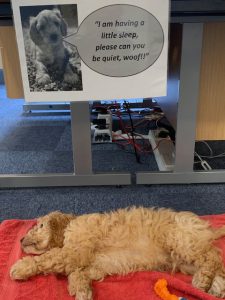
Over the last six months plus we have been discussing the benefit of having a school dog at both the secondary and primary schools. After much research and discussions with the CEO, the School Governors, other SEN schools and colleges who have successfully introduced a dog, we believe it would be of great benefit to our pupils. For this reason, we have decided to introduce a school dog to the pupils and staff prior to the half term break. Initially he will come into school for a few hours and then gradually to three days a week.
Simba is owned by Ms Palmer and lives with her and her young family, so will have a great deal of contact with young children. We have looked into the various breeds that make successful school dogs and have chosen a Cockapoo, which is a cross between a cocker spaniel and a toy poodle. He a medium sized dog known for its friendliness. We have introduced Simba as a puppy on a gradual basis, so he can become familiar with the school environments and then gradually meet the pupils. We have bought a trainer into school to support both the staff and pupils to ensure there is consistency in the way he will be handled and looked after.
Academic research has shown that dogs working and helping in the school environment can achieve the following:
The following information has been taken from a range of sources to provide further detail about the benefits of having a dog in school:
Behaviour:
In some schools, dogs are making a difference in the behaviour of pupils. Researchers report that students can identify with animals, and with empathy for the dog, can better understand how classmates may feel. It was found that violent behaviour in participating students declined by 55%, and general aggression went down 62%. Behaviour problems occur in school and these can interfere with learning. Some schools are using dogs to improve behaviour problems by promoting positive behaviour in students. In a controlled study, students were found to have fewer disciplinary referrals in schools with a dog than schools without. Students’ behaviour improved toward teachers, and students also showed more confidence and responsibility. Additionally, parents reported that children seemed more interested in school as a result of having a dog at school.
Attendance:
Having a school dog has proven to have an impact on pupil attendance. Those with who have low level attendance work with the dog in small groups and if they come to school regularly, they are rewarded by taking the dog for a walk. It makes them feel quite special with their attendance improving massively.
Education:
Reading programmes with dogs are doing wonders for some students. Children who might be embarrassed to read aloud to the class or even adults are likely to be less scared to read to a dog. “It might be less stressful for a child to read aloud to a dog than to a teacher or a peer. After all, a dog won’t judge or correct you.” Dogs are used to encourage struggling readers to practise reading aloud. With the presence of a “calm and well-trained dog,” students find social support and peer interaction.
Dogs are incredibly calm and happy to have student read to them or join a group of children in the library whilst they are having a book reading session. Dogs give unconditional acceptance, as they are non-judgmental, which is especially crucial to struggling, emerging readers. The dogs also provide confidence to children as they do not make fun of them when they read, but above all they make amazing listeners, providing the children with a sense of comfort and love. Research has proved that students who read to dogs show an increase in reading levels, word recognition, a higher desire to read and write, and an increase in intra and interpersonal skills among the students they mix with.
Social Development:
Dogs in school offer an opportunity for improving social development. They are especially useful for teaching students social skills and responsibility. Specifically, schools are using dogs to help older students build self-esteem; learn about positive and negative reinforcement, responsibility, and boundaries. Older students use dogs to help communicate, teach kindness, and empower students.
With a dog in school, students have the opportunity to learn how to care for the animal. This includes walking and grooming. Researchers report that involving students in the daily care of classroom dogs is a positive experience, promoting their own daily care. The students also learn about responsibility, caring, and sharing when helping each other take care of a dog at school.
As a reward:
Dogs will be gentle and loving, but at the same time full of fun and enjoyment for the students. Those students who have performed incredibly well during the week or those who have made progress in a certain subject, or those who have achieved tasks set for them, will be rewarded with spending time during lunch or break to interact with these dogs. Walking, grooming, playing and training are some of the responsibilities students will be allowed to undertake. It has been proved that working and playing with a dog improves children’s social skills and self-esteem.
Support Dogs can work with students on a one-one basis and will especially help those students who have been bullied, abused, going through upsetting/difficult times or even scared/phobic of dogs. The dog will bring much joy and help to all the students they meet and are happy to provide plenty of hugs to the students they are spending time with. Students who struggle with social interaction can find a reassuring friend in a dog.
It is recommended that school dogs cannot take part in active sessions until it is 12 months old. Until this time the Simba will simply be coming into school, getting comfortable with the school environment, going for walks with pupils and staff during break and lunch times. Please be assured that pupils will never be left alone with the dog.
If you would like to discuss Simba further with me, please do get in touch. I also understand that some pupils may have a fear of dogs or have allergies to dogs/animals. If this is the case for your child please let me know, we will not put your child in a situation, which he feels uncomfortable with. We would ideally like to be able to work with you and your child to overcome this fear.
Updated April 2019
Updated April 2019
Updated April 2019

| Cookie | Duration | Description |
|---|---|---|
| cookielawinfo-checkbox-analytics | 11 months | This cookie is set by GDPR Cookie Consent plugin. The cookie is used to store the user consent for the cookies in the category "Analytics". |
| cookielawinfo-checkbox-functional | 11 months | The cookie is set by GDPR cookie consent to record the user consent for the cookies in the category "Functional". |
| cookielawinfo-checkbox-necessary | 11 months | This cookie is set by GDPR Cookie Consent plugin. The cookies is used to store the user consent for the cookies in the category "Necessary". |
| cookielawinfo-checkbox-others | 11 months | This cookie is set by GDPR Cookie Consent plugin. The cookie is used to store the user consent for the cookies in the category "Other. |
| cookielawinfo-checkbox-performance | 11 months | This cookie is set by GDPR Cookie Consent plugin. The cookie is used to store the user consent for the cookies in the category "Performance". |
| viewed_cookie_policy | 11 months | The cookie is set by the GDPR Cookie Consent plugin and is used to store whether or not user has consented to the use of cookies. It does not store any personal data. |